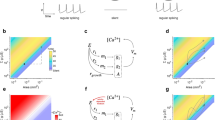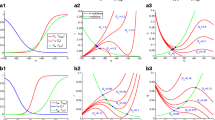Abstract
To maintain activity in a functional range, neurons constantly adjust membrane excitability to changing intra- and extracellular conditions. Such activity-dependent homeostatic regulation (ADHR) is critical for normal processing of the nervous system and avoiding pathological conditions. Here, we posed a homeostatic regulation problem for the classical Morris-Lecar (ML) model. The problem was motivated by the phenomenon of the functional recovery of stomatogastric neurons in crustaceans in the absence of neuromodulation. In our study, the regulation of the ionic conductances in the ML model depended on the calcium current or the intracellular calcium concentration. We found an asymptotic solution to the problem under the assumption of slow regulation. The solution provides a full account of the regulation in the case of correlated or anticorrelated changes of the maximal conductances of the calcium and potassium currents. In particular, the solution shows how the target and parameters of the regulation determine which perturbations of the conductances can be compensated by the ADHR. In some cases, the sets of compensated initial perturbations are not convex. On the basis of our analysis we formulated specific questions for subsequent experimental and theoretical studies of ADHR.








Similar content being viewed by others
Abbreviations
- ADHR:
-
activity-dependent homeostatic regulation
- ML:
-
model Morris-Lecar model
- STG:
-
stomatogastric
References
Arnold, V. I., Afrajmovich, V. S., Il’yashenko, Y. S., & Shil’nikov, L. P. (1994). Bifurcation theory and catastrophe theory. Berlin: Springer.
Barber, C. B., Dobkin, D. P., & Huhdanpaa, H. (1996). The quickhull algorithm for convex hulls. ACM Transactions on Mathematical Software, 22(4), 469–483.
Cressman, J. R., Jr., Ullah, G., Ziburkus, J., Schiff, S. J., & Barreto, E. (2009). The influence of sodium and potassium dynamics on excitability, seizures, and the stability of persistent states: I. Single neuron dynamics. Journal of Computational Neuroscience, 26(2), 159–170.
Cymbalyuk, G. S., Gaudry, Q., Masino, M. A., & Calabrese, R. L. (2002). Bursting in leech heart interneurons: cell-autonomous and network-based mechanisms. Journal of Neuroscience, 22(24), 10580–10592.
Davis, G. W. (2006). Homeostatic control of neural activity: from phenomenology to molecular design. Annual Review of Neuroscience, 29, 307–323.
Davis, G. W., & Bezprozvanny, I. (2001). Maintaining the stability of neural function: a homeostatic hypothesis. Annual Review of Physiology, 63, 847–869.
El-Samad, H., Goff, J. P., & Khammash, M. (2002). Calcium homeostasis and parturient hypocalcemia: an integral feedback perspective. Journal of Theoretical Biology, 214(1), 17–29.
El-Samad, H., Kurata, H., Doyle, J. C., Gross, C. A., & Khammash, M. (2005). Surviving heat shock: control strategies for robustness and performance. Proceedings of the National Academy of Sciences of the United States of America, 102(8), 2736–2741.
Ermentrout, E. (2002). Simulating, analyzing, and animating dynamical systems: A guide to XPPAUT for researchers and students. Philadelphia: SIAM.
Fellin, T., Pascual, O., & Haydon, P. G. (2006). Astrocytes coordinate synaptic networks: balanced excitation and inhibition. Physiology (Bethesda), 21, 208–215.
Fernandez, F. R., Engbers, J. D., & Turner, R. W. (2007). Firing dynamics of cerebellar purkinje cells. Journal of Neurophysiology, 98(1), 278–294.
Fields, R. D., Lee, P. R., & Cohen, J. E. (2005). Temporal integration of intracellular Сa2+ signaling networks in regulating gene expression by action potentials. Cell Calcium, 37(5), 433–442.
Fradkov, A. L., & Pogromsky, A. Y. (1998). Introduction to control of oscillations and chaos. Singapore: World Scientific.
French, L. B., Lanning, C. C., & Harris-Warrick, R. M. (2002). The localization of two voltage-gated calcium channels in the pyloric network of the lobster stomatogastric ganglion. Neuroscience, 112(1), 217–232.
Goaillard, J. M., & Marder, E. (2006). Dynamic clamp analyses of cardiac, endocrine, and neural function. Physiology (Bethesda), 21, 197–207.
Golowasch, J., Casey, M., Abbott, L. F., & Marder, E. (1999). Network stability from activity-dependent regulation of neuronal conductances. Neural Computation, 11(5), 1079–1096.
Guckenheimer, J., & Holmes, P. (1983). Nonlinear oscillations, dynamical systems, and bifurcations of vector fields. New York: Springer.
Gunay, G., & Prinz, A.A. (2009). Model calcium sensors for network homeostasis: Sensor and readout parameter analysis from a database of model neuronal networks. Journal of Neuroscience (in press).
Izhikevich, E. (2007). Dynamical systems in neuroscience. Cambridge: MIT.
Khorkova, O., & Golowasch, J. (2007). Neuromodulators, not activity, control coordinated expression of ionic currents. Journal of Neuroscience, 27(32), 8709–8718.
Kunjilwar, K. K., Fishman, H. M., Englot, D. J., O’Neil, R. G., & Walters, E. T. (2009). Long-lasting hyperexcitability induced by depolarization in the absence of detectable Ca2+ signals. Journal of Neurophysiology, 101(3), 1351–1360.
Kuznetsov, Y., Levitin, V., & Skovoroda, A. (1996). Continuation of stationary solutions to evolution problems in content. In. Amsterdam: Centrum/Voor Wiskunde en Informatica.
LeMasson, G., Marder, E., & Abbott, L. F. (1993). Activity-dependent regulation of conductances in model neurons. Science, 259(5103), 1915–1917.
Liu, Z., Golowasch, J., Marder, E., & Abbott, L. F. (1998). A model neuron with activity-dependent conductances regulated by multiple calcium sensors. Journal of Neuroscience, 18(7), 2309–2320.
Luther, J. A., Robie, A. A., Yarotsky, J., Reina, C., Marder, E., & Golowasch, J. (2003). Episodic bouts of activity accompany recovery of rhythmic output by a neuromodulator- and activity-deprived adult neural network. Journal of Neurophysiology, 90(4), 2720–2730.
MacLean, J. N., Zhang, Y., Johnson, B. R., & Harris-Warrick, R. M. (2003). Activity-independent homeostasis in rhythmically active neurons. Neuron, 37(1), 109–120.
MacLean, J. N., Zhang, Y., Goeritz, M. L., Casey, R., Oliva, R., Guckenheimer, J., et al. (2005). Activity-independent coregulation of ia and ih in rhythmically active neurons. Journal of Neurophysiology, 94(5), 3601–3617.
Marder, E., & Prinz, A. A. (2002). Modeling stability in neuron and network function: The role of activity in homeostasis. Bioessays, 24(12), 1145–1154.
Marder, E., & Goaillard, J. M. (2006). Variability, compensation and homeostasis in neuron and network function. Nature Reviews Neuroscience, 7(7), 563–574.
Marder, E., Abbott, L. F., Turrigiano, G. G., Liu, Z., & Golowasch, J. (1996). Memory from the dynamics of intrinsic membrane currents. Proceedings of the National Academy of Sciences of the United States of America, 93(24), 13481–13486.
McAnelly, M. L., & Zakon, H. H. (2000). Coregulation of voltage-dependent kinetics of Na(+) and N(+) currents in electric organ. Journal of Neuroscience, 20(9), 3408–3414.
Miller, J. P., & Selverston, A. I. (1982). Mechanisms underlying pattern generation in lobster stomatogastric ganglion as determined by selective inactivation of identified neurons. II. Oscillatory properties of pyloric neurons. Journal of Neurophysiology, 48(6), 1378–1391.
Mizrahi, A., Dickinson, P. S., Kloppenburg, P., Fenelon, V., Baro, D. J., Harris-Warrick, R. M., et al. (2001). Long-term maintenance of channel distribution in a central pattern generator neuron by neuromodulatory inputs revealed by decentralization in organ culture. Journal of Neuroscience, 21(18), 7331–7339.
Morris, C., & Lecar, H. (1981). Voltage oscillations in the barnacle giant muscle fiber. Biophysical Journal, 35(1), 193–213.
Nelson, S. B., & Turrigiano, G. G. (2008). Strength through diversity. Neuron, 60(3), 477–482.
Olypher, A. V., & Calabrese, R. L. (2007). Using constraints on neuronal activity to reveal compensatory changes in neuronal parameters. Journal of Neurophysiology, 98(6), 3749–3758.
Olypher, A. V., & Prinz, A. A. (2008). Restrictions on intrinsic neuronal properties following from models of homeostatic regulation of neuronal activity. Abstract Viewer/Itinerary Planner. Washington, DC: Society for Neuroscience Abstracts online. Program No. 376.13.
Olypher, A. V., & Calabrese, R. L. (2009). How does maintenance of network activity depend on endogenous dynamics of isolated neurons? Neural Computation, 21(6), 1665–1682.
Olypher, A. V., Cymbalyuk, G., & Calabrese, R. L. (2006). Hybrid systems analysis of the control of burst duration by low-voltage-activated calcium current in leech heart interneurons. Journal of Neurophysiology, 96(6), 2857–2867.
Petersen, O. H., & Verkhratsky, A. (2007). Endoplasmic reticulum calcium tunnels integrate signalling in polarised cells. Cell Calcium, 42(4–5), 373–378.
Prinz, A. A., Billimoria, C. P., & Marder, E. (2003). Alternative to hand-tuning conductance-based models: construction and analysis of databases of model neurons. Journal of Neurophysiology, 90(6), 3998–4015.
Prinz, A. A., Bucher, D., & Marder, E. (2004a). Similar network activity from disparate circuit parameters. Nature Neuroscience, 7(12), 1345–1352.
Prinz, A. A., Abbott, L. F., & Marder, E. (2004b). The dynamic clamp comes of age. Trends in Neuroscience, 27(4), 218–224.
Prinz, A. A., Smolinski, T. G., Soto-Trevino, C., & F.Nadim (2008). Conductance coregulations in a 2-compartment model of the anterior burster (ab) neuron in the lobster pyloric pacemaker kernel. Abstract Viewer/Itinerary Planner. Washington, DC: Society for Neuroscience Abstracts online. Program No. 376.9.
Rinzel, J., & Ermentrout, G. (1998). Analysis of neural excitability and oscillations. In C. Koch & I. Segev (Eds.), Methods in Neuronal Modeling: From Ions to Networks (pp. 251–291). Cambridge: MIT.
Schulz, D. J., Goaillard, J. M., & Marder, E. E. (2007). Quantitative expression profiling of identified neurons reveals cell-specific constraints on highly variable levels of gene expression. Proceedings of the National Academy of Sciences of the United States of America, 104(32), 13187–13191.
Sorensen, M., DeWeerth, S., Cymbalyuk, G., & Calabrese, R. L. (2004). Using a hybrid neural system to reveal regulation of neuronal network activity by an intrinsic current. Journal of Neuroscience, 24(23), 5427–5438.
Stellwagen, D., & Malenka, R. C. (2006). Synaptic scaling mediated by glial tnf-alpha. Nature, 440(7087), 1054–1059.
Taylor, A. L., Hickey, T. J., Prinz, A. A., & Marder, E. (2006). Structure and visualization of high-dimensional conductance spaces. Journal of Neurophysiology, 96(2), 891–905.
Thoby-Brisson, M., & Simmers, J. (2002). Long-term neuromodulatory regulation of a motor pattern-generating network: Maintenance of synaptic efficacy and oscillatory properties. Journal of Neurophysiology, 88(6), 2942–2953.
Turrigiano, G. G. (1999). Homeostatic plasticity in neuronal networks: the more things change, the more they stay the same. Trends in Neuroscience, 22(5), 221–227.
Turrigiano, G. G., & Nelson, S. B. (2004). Homeostatic plasticity in the developing nervous system. Nature Reviews Neuroscience, 5(2), 97–107.
Ullah, G., Cressman, J. R., Jr., Barreto, E., & Schiff, S. J. (2009). The influence of sodium and potassium dynamics on excitability, seizures, and the stability of persistent states. II. Network and glial dynamics. Journal of Computational Neuroscience, 26(2), 171–183.
Zhang, Y., & Golowasch, J. (2007). Modeling recovery of rhythmic activity: hypothesis for the role of a calcium pump. Neurocomputing, 70(10–12), 1657–1662.
Zhang, Y., Khorkova, O., Rodriguez, R., & Golowasch, J. (2008). Activity and neuromodulatory input contribute to the recovery of rhythmic output after decentralization in a central pattern generator. Journal of Neurophysiology, 101(1), 372–386.
Acknowledgements
The authors thank L. Abbott, R. Calabrese, C. Gunay, and A. Hudson for helpful discussions, and the reviewers for inspiring and helpful comments. Supported by NIH Grant 1 R01 NS054911-01A1 from NINDS.
Author information
Authors and Affiliations
Corresponding author
Additional information
Action Editor: J. Rinzel
Rights and permissions
About this article
Cite this article
Olypher, A.V., Prinz, A.A. Geometry and dynamics of activity-dependent homeostatic regulation in neurons. J Comput Neurosci 28, 361–374 (2010). https://doi.org/10.1007/s10827-010-0213-z
Received:
Revised:
Accepted:
Published:
Issue Date:
DOI: https://doi.org/10.1007/s10827-010-0213-z




